
* The outbreak of war in the Pacific on 7 December 1941 caught the USA off guard, with America and her allies suffering repeated thrashings at the hands of the Japanese for months. The stinging defeat of the Japanese at Midway Island in June 1942 marked the high tide of the Japanese offensive; the Americans then began to consider how best to take the offensive in turn.
* After the Japanese attacked the US Navy base at Pearl Harbor in Hawaii on 7 December 1941, Imperial Japan appeared unstoppable. The Americans were crushed in the Philippines, the British were run out of Hong Kong and Southeast Asia, and the Dutch East Indies were overrun. The Japanese seized a widespread network of islands in the Pacific to provide bases to protect their new empire, and pushed southeast towards Australia:
In early May 1942, a naval thrust intended to extend Japanese control southwest of New Guinea was blunted and forced to turn back in the Battle of the Coral Sea. The US Navy got somewhat the worse in the fight, but it was a strategic victory, and it also demonstrated that the US could hold its own in a fight with the Imperial Japanese Navy (IJN).
Japan's war machine then suffered a major blow in early June 1942, when the IJN suffered disastrous losses in a confrontation with the US Navy near Midway Island. Midway marked the end of Japan's blitzkrieg in the Pacific; the Japanese had been approaching the limits of their offensive capability in any case, but Midway was an emphatic statement that Japan's days of easy victories were over. The Japanese still retained substantial military power, but the initiative had slipped from their grasp. With their forces dispersed over such a wide area, they were vulnerable to Allied counterstrokes -- if such could be arranged.
BACK_TO_TOP* The Americans had been staggered by the savage beatings they had taken in the early months of the war in the Pacific, and the US was burdened by the necessity of fighting the war in Europe as well. Strategically, the Pacific Theater was of secondary importance; American doctrine was focused on a "Europe First" strategy, in which the USA focused on defeating Nazi Germany while performing holding actions in the Pacific until Germany was crushed. Although US Navy brass agreed with "Europe First" in principle, they still believed that resources could and should be spared to halt the Japanese advance, or hopefully put it in reverse. There was no sense in allowing the Japanese to grab more territory, or letting them consolidate their holdings, since that would make dislodging them in the future all that more expensive.
In particular, the US needed to protect Australia -- that country's prime minister, John Curtin, having asked for American help in the last days of 1941, with subsequent events underlining the threat to Australia. In hindsight, the Japanese didn't have the capability to conquer Australia, but at the time it appeared frighteningly plausible to Australians that they could. There was certainly nothing unrealistic in being frightened about Japanese conquests of the island regions around Australia, since that would allow the Japanese to bomb the Australian mainland and threaten Australia's supply lines. The Japanese didn't need to conquer Australia if they could isolate it.
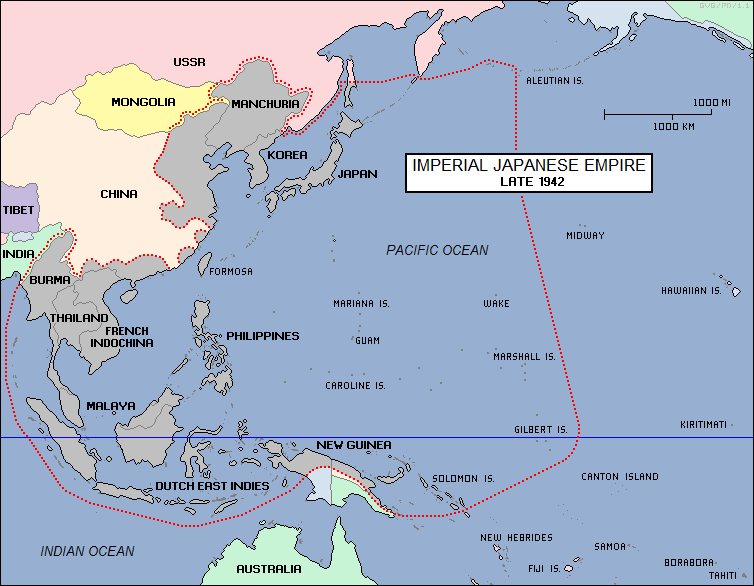
The defense of Australia was an obvious necessity from the American strategic point of view. Military forces and material were quickly loaded up on convoys to be sent to Australia and New Zealand. To support the convoys, as well as air traffic along the same route, the US had to establish a string of bases on islands in the South Pacific. In February 1942, US Army units had arrived on the atoll of Kiritimati -- pidgin English for "Christmas Island" -- in the Line Islands south of Hawaii just above the equator; they also occupied Canton Island, in the Phoenix group to the southwest, a stepping stone to US base facilities in American Samoa.
The Navy had been working on base facilities in the Pacific from before Pearl Harbor, but most of the work had been done by civilian contractors. Some of these workers were captured by the Japanese on Guam, Wake Island, and in the Philippines, and it was obvious that construction would have to be performed by Navy personnel instead -- civilians hadn't signed up to be in the line of fire, and it would be nice to have construction teams that could fight back if it came to that.
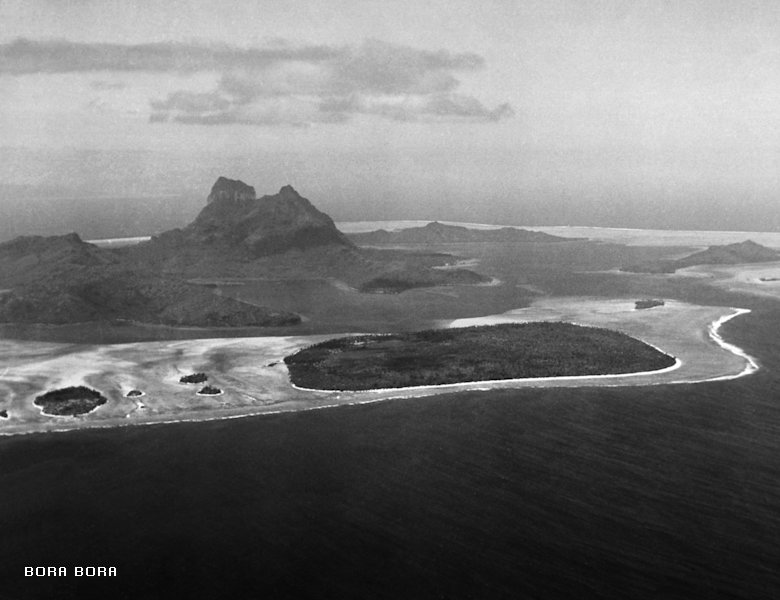
As a start, a scratch "construction detachment" was assembled from existing Navy personnel with background in construction and dispatched to Borabora Island in French Polynesia, a few hundred kilometers west of Tahiti. Borabora's military codename was BOBCAT, so this pioneering naval construction team was given the nickname of "BOBCATs". They arrived on Borabora in mid-February to set up a naval refueling stop. The expedition had been thrown together in great haste, the result being that much in the way of necessary kit and supplies were missing, but with the application of effort -- and, no doubt, considerable use of foul language -- the base was built.
* The BOBCAT base established the linchpin for the route south from Hawaii through Kirimati to Borabora. That left bases to be established on the island groups stretching to the west from Borabora to Australia:
New Caledonia is the largest island of the lot, about 400 kilometers (250 miles) long. To give an indication of just how far-flung these island groups are, the distance from the town of Noumea on New Caledonia, to Auckland on northern New Zealand to the south is over 1,800 kilometers (1,100 miles), while the distance to Brisbane in Australia to the west is over 1,470 kilometers (910 miles).
The US Army recognized quickly the importance of New Caledonia, not merely because of its strategic location and size, but also because of its deposits of chromium and other important minerals. A convoy had been hastily assembled and sent out from New York City in late January 1942, carrying components of what was supposed to be a division, to arrive at Noumea, New Caledonia in mid-March 1942 after a short layover in Melbourne, Australia. The half-formed division set up camp and began to establish base facilities, being formally placed under the command of US Army Major General Alexander M. "Sandy" Patch.
Given the frantic way the expedition had been put together, there was no doubt also considerable use of foul language by American troops in New Caledonia, aggravated by difficulties with the locals. New Caledonia was a French territory, and the local French population was unsurprisingly demoralized by events in Europe and then events in the Pacific. Given the string of defeats suffered by American arms to that time, the locals were not much reassured or encouraged by the arrival of the US Army.
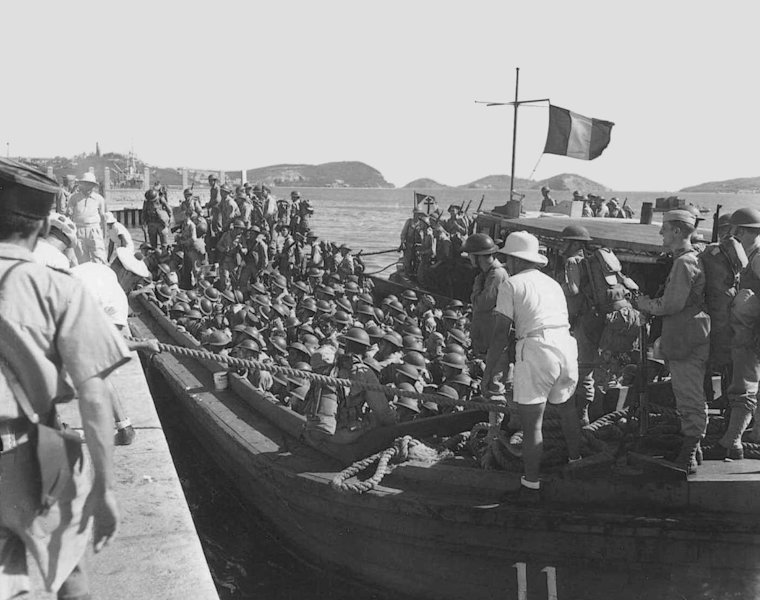
In addition, while New Caledonia had formally thrown in its lot with the Free French movement -- the island being under the direction of Free French Admiral George-Thierry d'Argenlieu -- there were still many French on the island more sympathetic to the Axis-leaning French Vichy regime. At the time of the American landing there was unrest in progress, but a US Army officer assigned to sort out what was going on was told not to worry too much, being reassured with Gallic casualness: "They always hold revolutions here." The Americans helped calm matters by providing weapons to the French Home Guard on the island, ensuring that the Free French retained control.
The American troops persevered and sorted things out. A detachment was also sent north soon after the initial landing at Noumea to Efate island, at the southern end of the New Hebrides, to begin establishment of an airbase there, closer to the front lines. The detachment had no idea if the Japanese had beaten them to Efate or not and came ashore prepared for combat -- to find to their relief no Japanese shooting at them. There was also thought of setting up bases in the Santa Cruz Islands, but a survey effort showed they were much too rugged and too pestilential to be worth the bother. In late May, Patch's division became formally known as the "Americal" division, for "Americans in New Caledonia". It was not given a division number at the time.
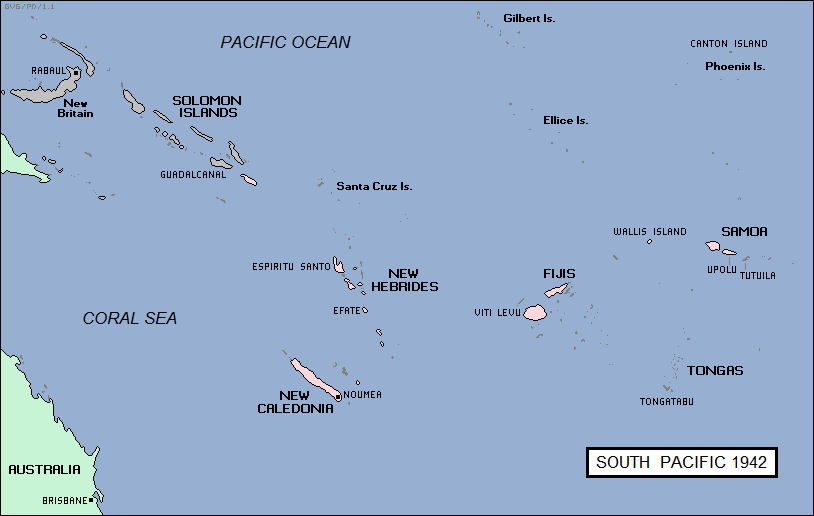
* Most of the work on the South Sea island bases fell to the Navy, however. The BOBCAT team sent to Borabora was only the first installment of a vast effort. Even as the BOBCAT team was being dispatched, experienced civilian construction workers were being recruited by the US Navy as fast as possible, to be given a bit of drill and combat training, then organized as "construction battalions" -- "CBs", becoming quickly known as the "Seabees".
As quickly as the battalions were trained and organized, they were shipped out to the South Pacific. The construction battalions were typically split in half, with each detachment sent to a different island to set up base facilities, usually accompanied by Army ground forces for security. In May 1942, the Seabees landed at:
In June, Seabees arrived at:
Despite all the organizational chaos and limited resources, by the summer of 1942 the US had done much to secure the South Pacific from further Japanese advances. On the combat lines, US and Australian forces were continuing the fight for control of New Guinea; fighting would soon intensify elsewhere in the region.
BACK_TO_TOP* Beginning in 1919, the Royal Australian Navy had organized a network of volunteer observers on the coast of Australia. These "coastwatchers" reported any strange incidents, such as the appearance of foreign or unknown vessels and aircraft. In 1939, in response to reports that the Japanese seemed unusually interested in the islands to the north, the Australians expanded the coastwatcher network to those islands. The island coastwatchers were recruited from local traders, government workers, planters, and missionaries who knew their surroundings well and had good relationships with the locals. The coastwatchers were given radios and special codes for sending information back to the Australian intelligence network. They were instructed to avoid combat, and hidden emergency stations were set up where they could continue to operate even if their islands were captured.
The coastwatchers were the primary Allied "early warning" system in the Solomons chain. Looking at a map of the Solomons doesn't give a good idea of the extent of the archipelago. The chain is about 1,450 kilometers (900 miles) long. The largest islands in the chain are, from the northwest to the southeast, Bougainville; Choiseul; New Georgia; Santa Isabel; Guadalcanal; Malaita; and San Cristobal. Bougainville is the largest island in the chain, a little over 160 kilometers (100 miles) long, about the size of the US state of Massachusetts. Guadalcanal is slightly smaller. North of Guadalcanal is the smaller Florida Island, which possesses a fine natural harbor on its south coast, protected from the open sea by the tiny island of Tulagi, then the British administrative capital of the Solomons.
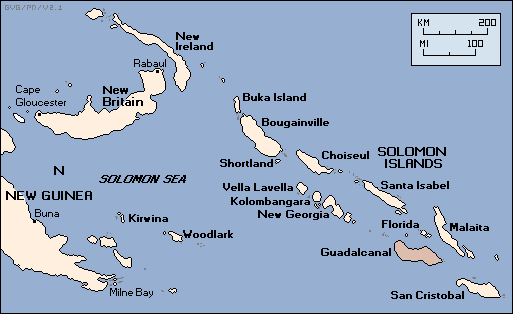
Although the Japanese were focused on the campaign in New Guinea, a flanking operation to help isolate Australia seemed practical and desireable, with the unprotected Solomons a very attractive target. On 3 May 1942, in parallel with the Battle of the Coral Sea, the Japanese moved in and occupied Tulagi, the inhabitants having enough advance warning to ship out before they were captured. US Navy aircraft from the carrier YORKTOWN hit the Japanese on Tulagi the next day, 4 May, pilots reporting back that they had inflicted major damage -- though in reality, they had only sunk a handful of small vessels. The Tulagi raid amounted to little more than an energetic but sloppily-executed training exercise.
In June, coastwatchers reported that the Japanese had also occupied the northwest coast of Guadalcanal opposite Florida Island. From there, the Japanese would be able to stage attacks on Allied bases in the New Hebrides, New Caledonia, the Fijis, and Samoa, and interfere with shipping between the US and Australia. If Tulagi and Guadalcanal were not retaken quickly, the Japanese would strengthen their oceanic barrier between Australia and the USA.
* The Japanese threat in the Solomons led to a political struggle in Washington DC over the proper response. Technically, the Solomons fell under the responsibility of Army General Douglas MacArthur, who in March had been assigned command of the "Southwest Pacific Area". This included an enormous arc of territory, curving down from the Philippines, through Southeast Asia and the East Indies, and then into Australia, New Guinea, and many of the island chains in the area. MacArthur directed operations from his headquarters in Melbourne.
The Pacific to the north and east of MacArthur's command was similarly designated the "Pacific Ocean Areas", and was the responsibility of Admiral Chester W. Nimitz, operating from his headquarters in Honolulu. His domain included the Marshalls, the Carolines, the Marianas, the Fijis, Samoa, New Caledonia, the New Hebrides, and New Zealand.
This division of the Pacific Theater into Navy and Army zones was a political contraption; it would always cause friction, the frictions being particularly intense at the outset. MacArthur and Nimitz agreed that the only way to eliminate the Japanese threat to Australia was to retake Rabaul. They differed, however, on the means of doing so. MacArthur wanted to attack Rabaul directly, using two of Nimitz's carriers and the 1st Marine Division to help do the job. MacArthur felt he could drive the Japanese out of the area in a few weeks. Although in hindsight such a proposal was a fantasy, even the moderate Army Chief of Staff, General George Marshall, was enthusiastic enough to press the idea with his opposite number, Chief of Naval Operations Admiral Ernest J. King.
The Navy was appalled at the idea. The Navy's precious carriers would have little room for maneuver in the approaches to Rabaul and would be subject to persistent attacks from Japanese aircraft based there. MacArthur's towering egotism and overbearing style did nothing to ease Navy fears. The Navy wanted to take Guadalcanal first, and insisted that it should be a Navy operation, since all the American resources involved were Navy. Admiral King was every bit as big an SOB as MacArthur and rejected the Army's plans in blunt terms. MacArthur exploded, sending angry messages back to Washington that accused the Navy of trying to take over the whole show.
The diplomatic Marshall sat down with King and talked it out. King was not always an easy person to deal with, but he was far from stupid and Marshall's credibility, coolness, and sensibility were enough to allow them to come to an agreement. To resolve the dispute, the Joint Chiefs of Staff adjusted the border between the domains of MacArthur and Nimitz. Nimitz would get his assault on Guadalcanal and Tulagi. MacArthur was assigned to move against the Japanese in eastern New Guinea; Rabaul; and the Western Solomons.
The plan was approved by the Joint Chiefs of Staff on 2 July 1942. At the time, the military situation for the Allies was extremely desperate. The Germans had just seized Sevastopol in the Crimea, the British were in full retreat back to Egypt in North Africa, and German U-boats were sinking Atlantic convoy shipping at an appalling rate. Marshall regarded it as "a very black hour."
BACK_TO_TOP